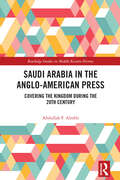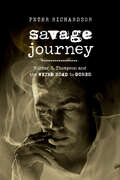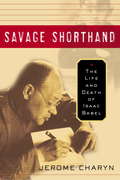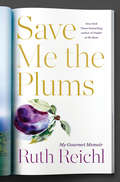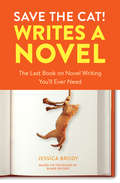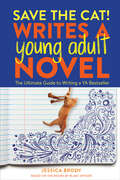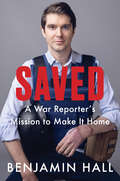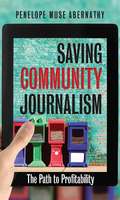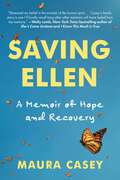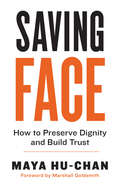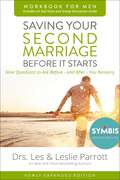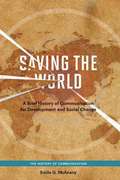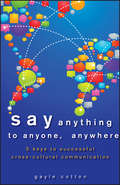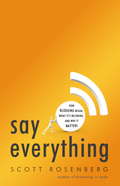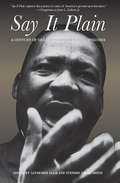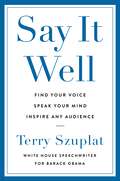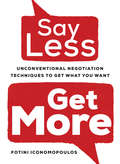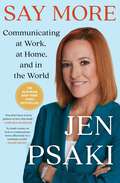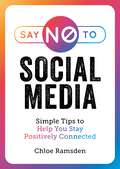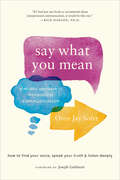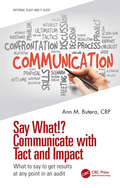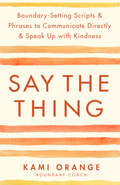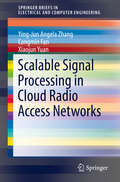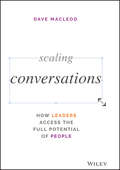- Table View
- List View
Saudi Arabia in the Anglo-American Press: Covering the Kingdom during the 20th Century (Routledge Studies in Middle Eastern History)
by Abdullah F. AlrebhThis book provides an in-depth analysis of authority structures in Saudi Arabia during the twentieth century, as presented in two leading Western newspapers, The London Times and The New York Times. Beginning with a history of Saudi Arabia – from the building of the Kingdom in 1901, when Ibn Saud left his exile in Kuwait to recover Riyadh back from Al-Rasheed’s rule, until the death of King Fahd in 2005 – the author then outlines the theoretical framework of the book, specifically Weber’s original conception of authority. Weber’s notion of authority as having three types – traditional, charismatic, and rational-legal – is applied to an analysis of the two newspapers over the course of the twentieth century. A timeline is devised to aid this analysis, based on significant turning points in Saudi history, including Ibn Saud’s declaration of the Kingdom in 1932 and King Faisal’s assassination in 1975. Ultimately, this analysis discloses the many ways in which conceptions of authority in the Middle East were presented to Western audiences, whilst illuminating the political agendas inherent to this coverage in the UK and the US. This book is vital reading for anyone interested in Saudi Arabian history, Western perspectives of the Middle East, and the sociology of media.
Savage Journey: Hunter S. Thompson and the Weird Road to Gonzo
by Peter RichardsonA superbly crafted study of Hunter S. Thompson’s literary formation, achievement, and continuing relevance. Savage Journey is a "supremely crafted" study of Hunter S. Thompson's literary formation and achievement. Focusing on Thompson's influences, development, and unique model of authorship, Savage Journey argues that his literary formation was largely a San Francisco story. During the 1960s, Thompson rode with the Hell's Angels, explored the San Francisco counterculture, and met talented editors who shared his dissatisfaction with mainstream journalism. Author Peter Richardson traces Thompson's transition during this time from New Journalist to cofounder of Gonzo journalism. He also endorses Thompson's later claim that he was one of the best writers using the English language as both a musical instrument and a political weapon. Although Thompson's political commentary was often hyperbolic, Richardson shows that much of it was also prophetic. Fifty years after the publication of Fear and Loathing in Las Vegas, and more than a decade after his death, Thompson's celebrity continues to obscure his literary achievement. This book refocuses our understanding of that achievement by mapping Thompson's influences, probing the development of his signature style, and tracing the reception of his major works. It concludes that Thompson was not only a gifted journalist, satirist, and media critic, but also the most distinctive American voice in the second half of the twentieth century.
Savage Shorthand
by Jerome CharynHailed as the first great Soviet writer, Isaac Babel was at once a product and a victim of violent revolution. In tales of Cossack marauders and flashy Odessa gangsters, he perfectly captured the raw, edgy mood of the first years of the Russian Revolution. Masked, reckless, impassioned, charismatic, Babel himself was as fascinating as the characters he created. At last, in renowned author Jerome Charyn, Babel has a portraitist worthy of his quicksilver genius. Though it traces the arc of Babel’s charmed life and mysterious death, Savage Shorthand bursts the confines of straight biography to become a meditation on the pleasures, torments, and meanings of Babel’s art. Even in childhood, Babel seemed destined to leave a mark. But it was only when his mentor, Maxim Gorky, ordered him to go out into the world of revolutionary Russia that Babel found his true voice and subject. His tales of the bandit king Benya Krik and the brutal raids of the Red Cavalry electrified Moscow. Overnight, Babel was a celebrity, with throngs of admirers and a train of lovers. But with the rise of Stalin, Babel became a living ghost. Charyn brilliantly evokes the paranoid shadowland of the first wave of Stalin’s terror, when agents of the Cheka snuffed out artists like candle flames. Charyn’s chilling account of the circumstances of Babel’s death–hidden and lied about for decades by Stalin’s agents–finally sets the record straight. For Jerome Charyn, Babel is the writer who epitomizes the vibrancy, violence, and tragedy of literature in the twentieth century. InSavage Shorthand, Charyn has turned his own lifelong obsession with Babel into a dazzling and original literary work. From the Hardcover edition.
Save Me the Plums: My Gourmet Years
by Ruth ReichlTrailblazing food writer and beloved restaurant critic Ruth Reichl took the job (and the risk) of a lifetime when she entered the glamorous, high-stakes world of magazine publishing. Now, for the first time, she chronicles her groundbreaking tenure as editor in chief of Gourmet. “This is the rare case of an amazing writer living an amazing life.”—Ann Patchett When Condé Nast offered Ruth Reichl the top position at America’s oldest epicurean magazine, she declined. She was a writer, not a manager, and had no inclination to be anyone’s boss. Yet Reichl had been reading Gourmet since she was eight; it had inspired her career. How could she say no? This is the story of a former Berkeley hippie entering the corporate world and worrying about losing her soul. It is the story of the moment restaurants became an important part of popular culture, a time when the rise of the farm-to-table movement changed, forever, the way we eat. Readers will meet legendary chefs like David Chang and Eric Ripert, idiosyncratic writers like David Foster Wallace, and a colorful group of editors and art directors who, under Reichl’s leadership, transformed stately Gourmet into a cutting-edge publication. This was the golden age of print media—the last spendthrift gasp before the Internet turned the magazine world upside down. Complete with recipes, Save Me the Plums is a personal journey of a woman coming to terms with being in charge and making a mark, following a passion and holding on to her dreams—even when she ends up in a place she never expected to be.Advance praise for Save Me the Plums “No one writes about food like Ruth Reichl. She also happens to be a mesmerizing storyteller. I consider this book essential nourishment.”—Nigella Lawson“Endearing . . . Gourmet magazine readers will relish the behind-the-scenes peek at the workings of the magazine. . . . Reichl’s revealing memoir is a deeply personal look at a food world on the brink of change.”—Publishers Weekly (starred review) “Ruth Reichl is the best sort of storyteller—intimate, wise, frank, and completely engaging. Here she beautifully details her ten years running Gourmet, with all the triumphs and tribulations, and it’s a brilliant tale. Every page is rich and delicious; the book is such a treat!”—Susan Orlean, New York Times bestselling author of The Library Book
Save the Cat! Writes a Novel: The Last Book On Novel Writing You'll Ever Need (Save the Cat!)
by Jessica BrodyThe first novel-writing guide from the best-selling Save the Cat! story-structure series, which reveals the 15 essential plot points needed to make any novel a success.Novelist Jessica Brody presents a comprehensive story-structure guide for novelists that applies the famed Save the Cat! screenwriting methodology to the world of novel writing. Revealing the 15 "beats" (plot points) that comprise a successful story--from the opening image to the finale--this book lays out the Ten Story Genres (Monster in the House; Whydunit; Dude with a Problem) alongside quirky, original insights (Save the Cat; Shard of Glass) to help novelists craft a plot that will captivate--and a novel that will sell.
Save the Cat! Writes a Young Adult Novel: The Ultimate Guide to Writing a YA Bestseller (Save the Cat!)
by Jessica BrodyAn indispensable guide in the bestselling Save the Cat! story structure series that reveals the 15 essential plot points needed to make any young adult novel a success, from an accomplished novelist and the author of Save the Cat! Writes a Novel.In Save the Cat! Writes a Young Adult Novel, prolific author and story coach Jessica Brody presents a comprehensive story structure guide for anyone who wants to write a young adult novel by applying the famed Save the Cat! screenwriting methodology to the world of YA fiction. In this book, you will learn: • The fifteen &“beats&” (or plot points) that are necessary for crafting a successful story with a compelling character arc—including the Opening Image, Catalyst, Fun and Games, Bad Guys Close In, Dark Night of the Soul, and Finale• The ten universal story genres that will help you drill into what makes your type of story work, including those most commonly found in young adult novels like Rites of Passage, Superhero, Buddy Love, Institutionalized, and Golden Fleece• Quirky, original insights and writing tips like &“Save the Cat,&” the &“Shard of Glass,&” and the &“Dark Night Epiphany,&” that help you craft a story that will thrill and captivate teen readersFilled with practical advice, easy-to-follow templates, and &“beat sheets&” analyzing the structure of popular young adult novels such as Leigh Bardugo&’s Six of Crows, John Green&’s The Fault in Our Stars, and Lois Lowry&’s The Giver, this book is the ultimate reference for anyone who&’s ever dreamed of writing their own young adult bestseller.
Saved: A War Reporter's Mission to Make It Home
by Benjamin HallWhen veteran war reporter Benjamin Hall woke up in Kyiv on the morning of March 14, 2022, he had no idea that, within hours, Russian bombs would nearly end his life. As a journalist for Fox News, Hall had worked in dangerous war zones like Syria and Afghanistan, but with three young daughters at home, life on the edge was supposed to be a thing of the past. Yet when Russia viciously attacked Ukraine in February 2022, Hall quickly volunteered to go. A few weeks later, while on assignment, Hall and his crew were blown up in a Russian strike. With Hall himself gravely injured and stuck in Kyiv, it was unclear if he would make it out alive. <p><p>This is the story of how he survived—a story that continues to this day. For the first time, Hall shares his experience in full—from his ground-level view of the war to his dramatic rescue to his arduous, and ongoing, recovery. Going inside the events that have permanently transformed him, Hall recalls his time at the front lines of our world’s conflicts, exploring how his struggle to step away from war reporting led him back one perilous last time. Featuring nail-biting accounts from the many people across multiple countries who banded together to get him to safety, Hall offers a stunning look at complex teamwork and heartfelt perseverance that turned his life into a mission. <p><p>Through it all, Hall’s spirit has remained undaunted, buoyed by that remarkable corps of people from around the world whose collective determination ensured his survival. <p><p>Evocative, harrowing, and deeply moving, Saved is a powerful memoir of family and friends, of life and healing, and of how to respond when you are tested in ways you never thought possible.Benjamin Hall’s memoir includes a 16-page color photo insert. <p> <b>New York Times Bestseller</b>
Saving Community Journalism
by Penelope Muse AbernathyAmerica's community newspapers have entered an age of disruption. Towns and cities continue to need the journalism and advertising so essential to nurturing local identity and connection among citizens. But as the business of newspaper publishing collides with the digital revolution, and as technology redefines consumer habits and the very notion of community, how can newspapers survive and thrive? In Saving Community Journalism, veteran media executive Penelope Muse Abernathy draws on cutting-edge research and analysis to reveal pathways to transformation and long-term profitability. Offering practical guidance for editors and publishers, Abernathy shows how newspapers can build community online and identify new opportunities to generate revenue. Examining experiences at a wide variety of community papers--from a 7,000-circulation weekly in West Virginia to a 50,000-circulation daily in California and a 150,000-circulation Spanish-language weekly in the heart of Chicago--Saving Community Journalism is designed to help journalists and media-industry managers create and implement new strategies that will allow them to prosper in the twenty-first century. Abernathy's findings will interest everyone with a stake in the health and survival of local media.
Saving Ellen: A Memoir of Hope and Recovery
by Maura CaseyA coming-of-age memoir that follows a large, working-class Irish family as it plunges into chaos in the wake of a terminal diagnosis—and the author's own hidden struggle to endure when her sister's disease becomes the dark star around which they all revolve. Financial privation and her father&’s drunken scenes formed the backdrop to Maura Casey's childhood, but her sister Ellen&’s years-long struggle with kidney disease consumed her whole family. Determined to see Ellen live to adulthood, her mother fought medical advice to donate a kidney at a time when organ transplants were medical miracles. She concealed the true impact of that decision, which would affect the family for years to come. Set in Buffalo amidst the tumult of the 1960s and 70s, Saving Ellen traces the author's recovery from alcoholism and sexual assault and tells of her irrepressible older sister Ellen, who fought to claim her dream of becoming an athlete; her smart, feminist mother, whose World War II Army service prepared her to manage her own platoon of six children; and her adulterous, alcoholic father who, at the end, was haunted by his shortcomings and regrets. Despite the hard truths of her childhood, Saving Ellen is ultimately a story of humor at unexpected moments as well as the grace of reconciliation and gratitude.Saving Ellen will appeal to those who have endured the stress of caring for a chronically ill family member, with all the fraught choices that entails. Readers who have experienced the unique insanity of living in a large alcoholic family will recognize the mix of madness and humor that forms the foundation of daily life. Casey's story has parallels to Monica Wood&’s When We Were the Kennedys, which details the struggle her family began when her father died of a heart attack, and Jeannette Walls&’ The Glass Castle, with its tale of family dysfunction and siblings trying to help one another cope in a dilapidated house with an unstable father.
Saving Face: How to Preserve Dignity and Build Trust
by Maya Hu-ChanOrganizations now need to attract, retain, and motivate teams and employees across distance, time zones, and cultural differences. Building authentic and lasting human relations may be the most important calling for leaders in this century. According to management and global leadership specialist Maya Hu-Chan, the concept of "saving face" can help any leader preserve dignity and create more empathetic cross-cultural relationships. "Face" represents one's self-esteem, self-worth, identity, reputation, status, pride, and dignity. Saving face is often understood as saving someone from embarrassment, but it's also about developing an understanding of the background and motivations of others to discover the unique facets we all possess. Without that understanding, we risk causing others to lose face without even knowing it. Hu-Chan explains saving face through anecdotes and practical tools, such as her BUILD leadership model (Benevolence, Understanding, Interacting, Learning, and Delivery). This book illustrates how we can give face to create positive first impressions, avoid causing others to lose face, and, most importantly, build trust and lasting relationships inside and outside the workplace.
Saving Your Second Marriage Before It Starts Workbook for Men Updated: Nine Questions to Ask Before---and After---You Remarry
by Les and ParrottBuild your second marriage on more than a hope and a prayer. Sixty percent of second marriages fail, but yours can be among the ones that succeed. Relationship experts Les and Leslie Parrott show how you can beat the odds and make remarriage the best thing that's ever happened to you. More than a million couples have used the award-winning Saving Your Marriage Before It Starts to prepare for life-long love. And now, with Saving Your Second Marriage Before It Starts, Les and Leslie have added material for couples where one or both individuals are entering marriage for the second time. Uncover and understand the unique shaping factors you bring into your marriage as a man. Prepare for some surprising and helpful insights, for honest, intimate, and enjoyable relationship-strengthening conversations with you and your fiancée, and for engaging discussions with a small group.Over the course of twenty-eight exercises, this workbook will help couples identify and meld your love styles. You'll shed amazing new light on the way you're made, how that affects the way you and your loved one relate, and how you can improve those areas to build a better relationship. You will gain unprecedented insights into topics such as: facing the myths of remarriage honestly exploring unfinished business your personal &“Ten Commandments&” making your roles conscious assessing your self-image getting your sex life off to a great start cultivating intimacy listening to your self-talk avoiding the blame game how well do you communicate? your top ten needs mind reading how to listen identifying your &“hot topics&” money talks your spiritual journey becoming soul mates The personal exercises portion is followed by a discussion section: 9 Questions to Ask Before—and After—You Marry. Les and Leslie will help you enjoy lively and eye-opening interaction with each other and with a small group through nine sessions on the DVD (sold separately). The discussion guide, included in this workbook, guides you through an opening exercise, note-taking as you watch the video, linking to the workbook exercises, and group discussion, concluding with an exercise each couple can do together over the next week. Designed for use with Saving Your Marriage Before It Starts Workbook for Women Updated (9780310875710) and Saving Your Second Marriage Before It Starts Video Study (9780310885436), both sold separately.
Saving the World: A Brief History of Communication for Devleopment and Social Change
by Emile G. McananyThis far-reaching and long overdue chronicle of communication for development from a leading scholar in the field presents in-depth policy analyses to outline a vision for how communication technologies can impact social change and improve human lives. Drawing on the pioneering works of Daniel Lerner, Everett Rogers, and Wilbur Schramm as well as his own personal experiences in the field, Emile G. McAnany builds a new, historically cognizant paradigm for the future that supplements technology with social entrepreneurship. McAnany summarizes the history of the field of communication for development and social change from Truman's Marshall Plan for the Third World to the United Nations' Millennium Development Goals. Part history and part policy analysis, Saving the World argues that the communication field can renew its role in development by recognizing large aid-giving institutions have a difficult time promoting genuine transformation. McAnany suggests an agenda for improving and strengthening the work of academics, policy makers, development funders, and any others who use communication in all of its forms to foster social change.
Say Anything to Anyone, Anywhere: 5 Keys To Successful Cross-Cultural Communication
by Gayle CottonThe five steps to successful selling, negotiating, and managing multi-culturally Say Anything to Anyone, Anywhere gives readers five simple key guidelines to create rapport and organize strategies for success across different cultures.<P><P> This book teaches to be proactive, not reactive, in your cross-cultural communications and shows how to use simple rapport tools to create trust with the cultures you work with or travel to. Learn how to organize productive interactions in person, on the phone, and by email. Discover interpersonal communication skills and virtual strategies that build strong relationships. Offers quick, accessible examples and clear guidelines about how to create an understanding between cultures Gives tips and strategies on how to communicate without offending Author Gayle Cotton is a Emmy Award Winner and a distinguished, highly sought after speaker, corporate trainer, and executive coach. This step-by-step guide to cross-cultural business will help you build strong relationships and manage successfully, no matter the cultural differences.
Say Everything: How Blogging Began, What It's Becoming, and Why It Matters
by Scott RosenbergBlogs are everywhere. They have exposed truths and spread rumors. Made and lost fortunes. Brought couples together and torn them apart. Toppled cabinet members and sparked grassroots movements. Immediate, intimate, and influential, they have put the power of personal publishing into everyone’s hands. Regularly dismissed as trivial and ephemeral, they have proved that they are here to stay.In Say Everything, Scott Rosenberg chronicles blogging’s unplanned rise and improbable triumph, tracing its impact on politics, business, the media, and our personal lives. He offers close-ups of innovators such as Blogger founder Evan Williams, investigative journalist Josh Marshall, exhibitionist diarist Justin Hall, software visionary Dave Winer, "mommyblogger" Heather Armstrong, and many others. These blogging pioneers were the first to face new dilemmas that have become common in the era of Google and Facebook, and their stories offer vital insights and warnings as we navigate the future. How much of our lives should we reveal on the Web? Is anonymity a boon or a curse? Which voices can we trust? What does authenticity look like on a stage where millions are fighting for attention, yet most only write for a handful? And what happens to our culture now that everyone can say everything?Before blogs, it was easy to believe that the Web would grow up to be a clickable TV–slick, passive, mass-market. Instead, blogging brought the Web’s native character into focus–convivial, expressive, democratic. Far from being pajama-clad loners, bloggers have become the curators of our collective experience, testing out their ideas in front of a crowd and linking people in ways that broadcasts can’t match. Blogs have created a new kind of public sphere–one in which we can think out loud together. And now that we have begun, Rosenberg writes, it is impossible to imagine us stopping.In his first book, Dreaming in Code, Scott Rosenberg brilliantly explored the art of creating software ("the first true successor to The Soul of a New Machine," wrote James Fallows in The Atlantic). In Say Everything, Rosenberg brings the same perceptive eye to the blogosphere, capturing as no one else has the birth of a new medium.
Say It Plain: A Century of Great African American Speeches
by Booker T. Washington Jesse Jackson Clarence Thomas John Hope Franklin Julian Bond Martin Luther King Jr. Lani Guinier Howard Thurman Randall Robinson Stokely Carmichael Fannie Lou Hamer Joseph Lowery Dick Gregory Marcus Garvey Walter White Barbara Jordan Shirley Chisholm Thurgood Marshall Mary McLeod Bethune Charles Hamilton Houston Benjamin L. Hooks Louis Farrakhan Johnetta B. ColeA moving portrait of how black Americans have spoken out against injustice—with speeches by Thurgood Marshall, Shirley Chisholm, Jesse Jackson, and more. In &“full-throated public oratory, the kind that can stir the soul&”, this unique anthology collects the transcribed speeches of the twentieth century&’s leading African American cultural, literary, and political figures, many never before available in printed form (Minneapolis Star-Tribune). From an 1895 speech by Booker T. Washington to Julian Bond&’s sharp assessment of school segregation on the fiftieth anniversary of Brown v. Board in 2004, the collection captures a powerful tradition of oratory—by political activists, civil rights organizers, celebrities, and religious leaders—going back more than a century. Including the text of each speech with an introduction placing it in historical context, Say It Plain is a remarkable record—from the back-to-Africa movement to the civil rights era and the rise of black nationalism and beyond—conveying a struggle for freedom and a challenge to America to live up to its democratic principles. Includes speeches by: Mary McLeod BethuneJulian BondStokely CarmichaelShirley ChisholmLouis FarrakhanMarcus GarveyJesse JacksonMartin Luther King Jr.Thurgood MarshallBooker T. WashingtonWalter White
Say It Well: Find Your Voice, Speak Your Mind, Inspire Any Audience
by Terry SzuplatOne of Barack Obama’s longest-serving speechwriters reveals the public speaking lessons that will help you become a more confident and compelling communicator and leader.As a White House speechwriter, Terry Szuplat helped craft hundreds of speeches for President Obama. But when it came to public speaking himself, Szuplat—like many people—was gripped by anxiety and preferred to stay in the shadows. When he was invited to give the first major speech of his life, he faced a choice: keep hiding from what scared him, or finally face his fears.In Say It Well, Szuplat shares the life-changing lessons he learned from Barack Obama—one of the most admired speakers of our time—and how he applied these techniques to become a better speaker himself. In every chapter, he shares never-before-heard advice from Obama on speaking well, along with riveting behind-the-scenes stories of writing for a president—so you can master every step of public speaking, including:• Tips for overcoming stage fright• Best practices for using artificial intelligence to compose a memorable speech• Attention-grabbing openings to pull in any audience• Framing techniques to make your arguments more persuasive • Scientifically-proven ways to inspire people to action and to create the change you want• Tricks for editing, polishing, and practicing your words for maximum impact• The only way to end any great speechAlong the way, Szuplat introduces you to remarkable people from all walks of life—students, advocates, business executives, veterans—who have used these techniques to give speeches that have gone viral and inspired millions of people around the world. At a time of division and distrust, Say It Well also shows how we can all speak with the empathy, civility, and honesty that we need now more than ever.In sharing his journey to find his own voice, Szuplat will help you find yours. Written with humor and warmth, this is your new guide to the art of public speaking. And the next time you speak—whether you’re giving a toast or a eulogy for a loved one, a presentation at work, or an impassioned appeal for a cause you care about—not only will you know what to say, you’ll know how to say it well..
Say Less, Get More: Unconventional Negotiation Techniques to Get What You Want
by Fotini IconomopoulosNegotiation without fear, for everyone, everywhere Nicknamed “the negotiator” as a child, Fotini Iconomopoulos has been honing her skills her entire life. As a sought-after expert, for more than a decade she’s been empowering Fortune 500 executives and their teams to achieve their objectives, guiding them through high-stakes scenarios in industries such as consumer packaged goods, retail, professional services, energy, telecommunications, tech and finance. Now for the first time, Iconomopoulos shares her simple and innovative strategies, debunks common negotiation myths and explains why effective negotiation does not follow a one-size fits all/art of the deal approach. In Say Less, Get More you’ll find out how to: Assess where your situation falls on the negotiation spectrum so you can adjust your tactics accordinglyUnderstand who you are negotiating with, their background and their goals, in order to develop your approachDetermine your starting position, your final outcome and a strategy to get thereManage the negotiation process, overcome obstacles and find common groundCommunicate effectively in any scenario, including learning what to say and when to say it if you can’t reach a dealDevelop and foster excellent client relationships and networks Once you are armed with Iconomopoulos’s sensible strategies and proven advice, you’ll be able to confidently get what you want in business and in life.
Say More: Lessons from Work, the White House, and the World
by Jen PsakiINSTANT NEW YORK TIMES BESTSELLER Former White House Press Secretary and current MSNBC host Jen Psaki shares the surprising lessons she&’s learned on her path to success and offers unique yet universal advice about how to be a more effective communicator in any situation.Not many White House Press Secretaries capture the nation&’s interest the way Jen Psaki did. Refreshingly candid and clear, Psaki quickly became known for her ability to break through the noise and successfully deliver her message. In her highly anticipated book, Psaki shares her journey to the Briefing Room and beyond, taking you along the campaign trail, to the State Department, and inside the White House under two Presidents. With her signature wit, Psaki writes about reporting to bosses from the hot-tempered Rahm Emanuel to the coolly intellectual Barack Obama to the surprisingly tenderhearted John Kerry. She also talks about her time working closely with President Joe Biden from the start of his administration to set a new tone for the country, restoring a sense of calm and respect for the role of the media in our Democracy. Since leaving the White House, Psaki&’s star has continued to rise. She launched a highly rated show on MSNBC and was so successful that in just six months she was given an additional primetime Monday slot, ahead of Rachel Maddow. And Psaki&’s work doesn&’t end at the office. She is the mother of two young children and shares her stories about the journey of communicating as a parent: During one bedtime briefing, her young daughter asked the question, &“Why do wars start?&”, which Jen carefully explained and then got a follow up: &“Have you ever seen a unicorn?&” In Say More, Psaki explains her straightforward approach to communication, walking you through difficult conversations as well as moments where humor saves the day—whether it is with preschoolers, partners, or presidents. She addresses the best ways to give and receive feedback, how to connect with your audience, how to listen actively, and much more. Say More is the book Psaki wishes she had when she started her career, and is a trove of entertaining, essential lessons from one of the most prominent voices in American politics today.
Say No to Social Media: Simple Tips to Help You Stay Positively Connected
by Chloe RamsdenAre you familiar with FOMO? Do you often fall prey to the mindless scroll? Is the pressure of likes, follows and notifications getting you down? Although social media is a big part of modern life, using it can often leave us feeling drained, unfocused and unhappy – but it doesn’t have to be that way! This book has everything you need to put you back in the driving seat. With 100 practical tips, from switching off to curating positive feeds, you’ll find it easy to take the first steps towards a happier online life.
Say No to Social Media: Simple Tips to Help You Stay Positively Connected
by Chloe RamsdenAre you familiar with FOMO? Do you often fall prey to the mindless scroll? Is the pressure of likes, follows and notifications getting you down? Although social media is a big part of modern life, using it can often leave us feeling drained, unfocused and unhappy – but it doesn’t have to be that way! This book has everything you need to put you back in the driving seat. With 100 practical tips, from switching off to curating positive feeds, you’ll find it easy to take the first steps towards a happier online life.
Say What You Mean: A Mindful Approach to Nonviolent Communication
by Oren Jay SoferFind your voice, speak your truth, listen deeply—a guide to more meaningful and mindful conversations.We spend so much of our lives talking to each other, but how much are we simply running on automatic—relying on old habits and hoping for the best? Are we able to truly hear others and speak our mind in a clear and kind way, without needing to get defensive or go on the attack? In this groundbreaking synthesis of mindfulness, somatics, and Nonviolent Communication, Oren Jay Sofer offers simple yet powerful practices to develop healthy, effective, and satisfying ways of communicating. The techniques in Say What You Mean will help you to: · Feel confident during conversation · Stay focused on what really matters in an interaction · Listen for the authentic concerns behind what others say · Reduce anxiety before and during difficult conversations · Find nourishment in day-to-day interactions
Say What!? Communicate with Tact and Impact: What to say to get results at any point in an audit (Internal Audit and IT Audit)
by Ann M. ButeraThis book addresses the important role of communication within the context of performing an audit, project, or review (i.e., planning, detailed testing, and reporting). Intended for audit, information security, enterprise, and operational risk professionals at all levels, including those just starting out, Say What!? Communicate with Tact and Impact: What to Say to Get Results at Any Point in an Audit contains an array of practical and time-tested approaches that foster efficient and effective communication at any point during an engagement. The practical and memorable techniques are culled from author Ann M. Butera’s CRP experience as a trusted advisor who has taught thousands of professionals how to develop and hone their interpersonal, communication, and empathic skills. Those familiar with the Five Tier Competency ModelTM she developed will recognize these techniques as a deep dive on the competencies comprising Tier 3: Project Management and Tier 5: Managing Constituent Relations. The author discusses the following behaviors in one’s dealings with executives, process owners, control performers, and colleagues: Demonstrating executive presence Becoming the trusted advisor Influencing others Communicating with tact, confidence, and impact Facilitating productive meetings and discussions Overcoming resistance and objections Managing and resolving conflict Knowing when to let a topic go and move on This book is a guide for professionals who want to interact proactively and persuasively with those they work with, audit, or review. It describes techniques that can be used during virtual, in-person, telephone, or video conferences (as opposed to emails, workpapers, and reports). It provides everyone (newer associates in particular) with the interpersonal skills needed to (1) develop and build relationships with their internal constituents and clients, (2) facilitate conversations and discussions before and during meetings, and (3) handle impromptu questions with confidence and executive presence and make positive first impressions. The topics and techniques discussed are accompanied by case studies, examples, and exercises to give the readers the opportunity to develop plans to bridge the gap between theory and practice. The readers can use the book as a reliable resource when subject matter experts or training guides are not readily available.
Say the Thing: Boundary-Setting Scripts & Phrases to Communicate Directly & Speak Up with Kindness
by Kami OrangePacked with boundary-setting phrases and sample dialogue scripts, this book offers easy-to-remember guidance for navigating life's trickier conversations, and encourages readers to communicate kindly and directly on a variety of sensitive topics.If you are looking to learn how to express what you truly feel and ask for what you want in a kind and direct way, this book will help you take control of situations and set boundaries that work for you in your environment. Giving hundreds of examples of boundary phrases and conversation scripts, it&’s designed to be both easy to read and an accessible reference to pull out again and again when you need boundary-setting guidance. Featuring three boundary phrase frameworks and a multitude of topics for use in each, this book suggests communication strategies for speaking compassionately about:body image sexual orientationracerelationshipsand much more!With her friendly voice and a spark of humor, boundary coach Kami Orange is here to help you navigate life's tricky situations and learn how to stand up for yourself, for others, and to say the thing.
Scalable Signal Processing in Cloud Radio Access Networks (SpringerBriefs in Electrical and Computer Engineering)
by Ying-Jun Angela Zhang Congmin Fan Xiaojun YuanThis Springerbreif introduces a threshold-based channel sparsification approach, and then, the sparsity is exploited for scalable channel training. Last but not least, this brief introduces two scalable cooperative signal detection algorithms in C-RANs. The authors wish to spur new research activities in the following important question: how to leverage the revolutionary architecture of C-RAN to attain unprecedented system capacity at an affordable cost and complexity. Cloud radio access network (C-RAN) is a novel mobile network architecture that has a lot of significance in future wireless networks like 5G. the high density of remote radio heads in C-RANs leads to severe scalability issues in terms of computational and implementation complexities. This Springerbrief undertakes a comprehensive study on scalable signal processing for C-RANs, where ‘scalable’ means that the computational and implementation complexities do not grow rapidly with the network size. This Springerbrief will be target researchers and professionals working in the Cloud Radio Access Network (C-Ran) field, as well as advanced-level students studying electrical engineering.
Scaling Conversations: How Leaders Access the Full Potential of People
by Dave MacLeodFind out what your customers and employees are really thinking with this indispensable resource Scaling Conversations: How Leaders Access the Full Potential of People delivers invaluable strategies for how leaders can make their communications more inclusive and access the voices of those employees who rarely feel empowered to speak up. As constituent numbers scale, leaders have traditionally struggled to make communications a conversation with the entire organization, settling instead for small focus groups, talking at people in town halls, and delivering surveys after the fact. The result is exclusive, narrow decision-making that disengages and under-utilizes talent and human capital. And now, as the remote environment grows, the challenge and imperative for engaging conversations on a wider scale is even greater. Scaling Conversations provides the solution. Having led a remote team for over a decade and having worked with thousands of leaders across North America, Dave MacLeod teaches you how to: Scale your business by listening to the voices that really matter Access and maximize the human capital in your organization Make decisions that create unity and move the group forward Decrease employee turnover caused by poor communication Within these pages, you'll learn how to better facilitate conversations with a wider and more representative array of clients and employees, and not just the loudest ones in the town hall meeting or Slack channel. Perfect for any leader who's responsible for understanding what employees are really feeling and thinking, Scaling Conversations also belongs on the bookshelves of anyone who wants to learn how to discover what the “silent majority,” who are often drowned out by the loudest people in the room, actually believes.
